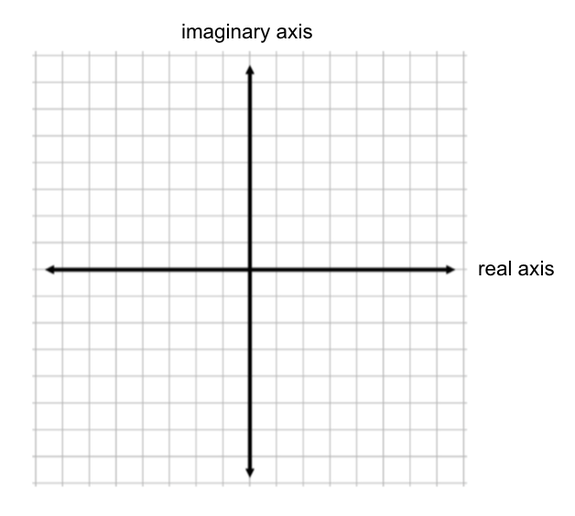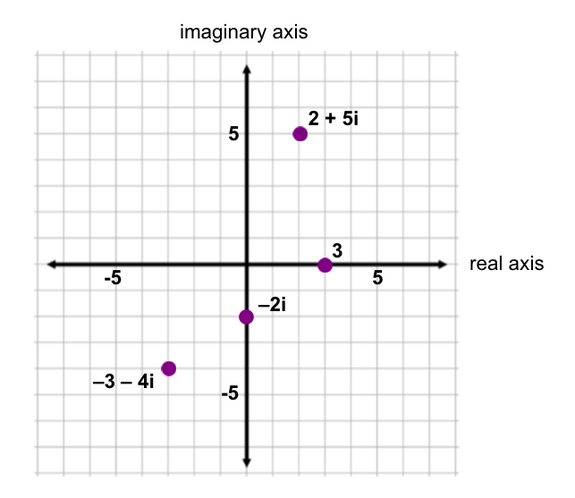Table of Contents |
A complex number is a number that contains a real part and an imaginary part, such as  . In mathematics, we deal with real numbers all the time. These are numbers that we can place on the number line, such as integers, decimals and fractions, and rational and irrational numbers. An imaginary number is not real, and contains the imaginary unit i, which is
. In mathematics, we deal with real numbers all the time. These are numbers that we can place on the number line, such as integers, decimals and fractions, and rational and irrational numbers. An imaginary number is not real, and contains the imaginary unit i, which is  . This is non-real because every real number squared is non-negative. So when a negative number is underneath a square root, there is no real number that it evaluates to.
. This is non-real because every real number squared is non-negative. So when a negative number is underneath a square root, there is no real number that it evaluates to.
In general, we write complex numbers in the form  .
.  is the real number component to the complex number, and
is the real number component to the complex number, and  is the imaginary number component to the complex number. Complex numbers represent a larger set of numbers than real numbers do, because the complex number system includes real numbers, and also includes the set of all imaginary numbers as well.
is the imaginary number component to the complex number. Complex numbers represent a larger set of numbers than real numbers do, because the complex number system includes real numbers, and also includes the set of all imaginary numbers as well.
 , containing a real part,
, containing a real part,  , and an imaginary part, bi, where i is the imaginary unit,
, and an imaginary part, bi, where i is the imaginary unit,  .
.We can represent complex numbers on what is called the complex plane. It is similar to the coordinate plane we use for graphing, but instead of x- and y-axes, we have a real axis and an imaginary axis. This is shown below:

We can plot complex numbers on the complex plane following a very similar process for plotting coordinate points (x, y) on the coordinate plane.
EXAMPLE
Plot the following points on the complex plane:




 and
and  . These numbers lie on one of the axes of the plane because they are either purely imaginary (having no real component) or purely real (having no imaginary component).
. These numbers lie on one of the axes of the plane because they are either purely imaginary (having no real component) or purely real (having no imaginary component).
There is an interesting pattern with the powers of the imaginary unit, i. The pattern is cyclical, which means that it repeats in cycles. Let's examine some of the powers of i:
| Power of i | Calculation | Result |
|---|---|---|

|

|

|

|

|

|

|

|

|

|

|

|

|

|

|

|

|

|

|

|

|

|

|

|
At this point, you can see that the powers of i follow the pattern: 
Notice that if the power is a multiple of 4, then the result is 1.
Since the pattern repeats, it is important to know the first four powers of i:

EXAMPLE
Simplify

|
Rewrite 32 in factored form so that 4 is one if its factors. |

|
Use exponent properties to rewrite. |

|

|

|
Simplify. |
As you can see, this process can be used if the power is any multiple of 4.
How can we find any power of i? The idea is that we look for the closest multiple of 4.
EXAMPLE
Simplify

|
Split the powers into one that’s a multiple of 4. |

|
We know  since 20 is a multiple of 4. since 20 is a multiple of 4.
|

|

|

|
Simplify. |

Another method to simplify higher powers of i is to use this algorithm:
EXAMPLE
Simplify

We can use our knowledge of powers of i to simplify more complex expressions.
EXAMPLE
Simplify

|
Use properties of exponents. |

|
 
|

|
Simplify. |

Looking at the previous example, we saw that  This also means that
This also means that  !
!
With the use of imaginary numbers, we can rewrite square roots of negative numbers. To do so, we use the property 
EXAMPLE
Suppose we want to rewrite Since
Since  we have the following:
we have the following:

|
Write -9 in factored form with -1 as one factor. |

|
Use properties of radicals to write as a product of radicals. |

|
 and and 
|
Let’s look at an example where the radicand is not a perfect square.
EXAMPLE
Simplify

|
Write -50 in factored form with -1 as one factor. |

|
Use properties of radicals to write as a product of radicals. |

|

|
 ” sign is left in the expression so that the i is not "too close" to the radical.
” sign is left in the expression so that the i is not "too close" to the radical.


|
Rewrite  since 25 is a perfect square. since 25 is a perfect square.
|

|
Separate the square roots. |

|

|
 Basically, the “nonradical” terms are written together before the radical term is. The expression
Basically, the “nonradical” terms are written together before the radical term is. The expression  could also be written
could also be written  but this can be confusing since it’s difficult to tell whether the i is not under the radical (it’s not).
but this can be confusing since it’s difficult to tell whether the i is not under the radical (it’s not).
Recall that the solutions to the quadratic equation  are
are 
When the discriminant  is negative, the equation is no real solution. With our knowledge of imaginary numbers, we can express the nonreal solutions in terms of i.
is negative, the equation is no real solution. With our knowledge of imaginary numbers, we can express the nonreal solutions in terms of i.
EXAMPLE
Find the solutions of the equation

|
Identify  b, and c. b, and c.
|

|
Replace all variables with their values. |

|
Simplify the radicand:  Simplify the denominator: 
|

|
Simplify the square root. |

|
Replace  with with 
|

|
Perform the division by 2 across all terms in the numerator. |
 and
and 
Finding complex solutions to a quadratic equation is very useful in the field of electrical engineering.
Source: THIS TUTORIAL HAS BEEN ADAPTED FROM "BEGINNING AND INTERMEDIATE ALGEBRA" BY TYLER WALLACE. ACCESS FOR FREE AT www.wallace.ccfaculty.org/book/book.html. License: Creative Commons Attribution 3.0 Unported License